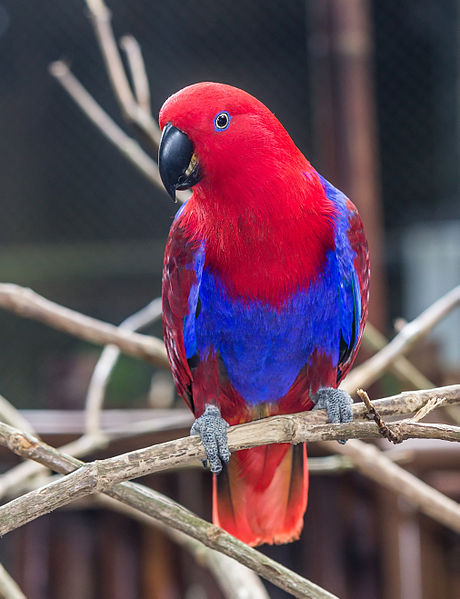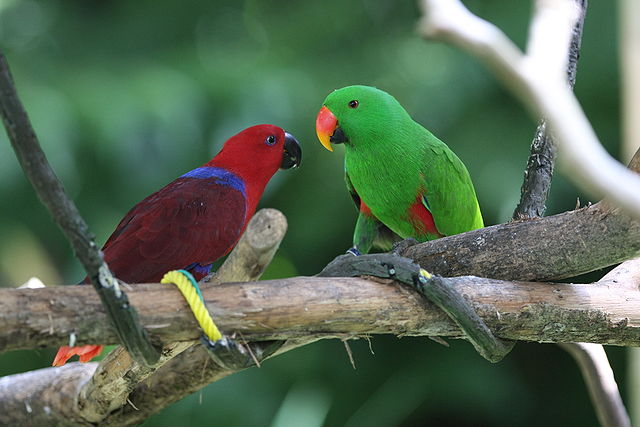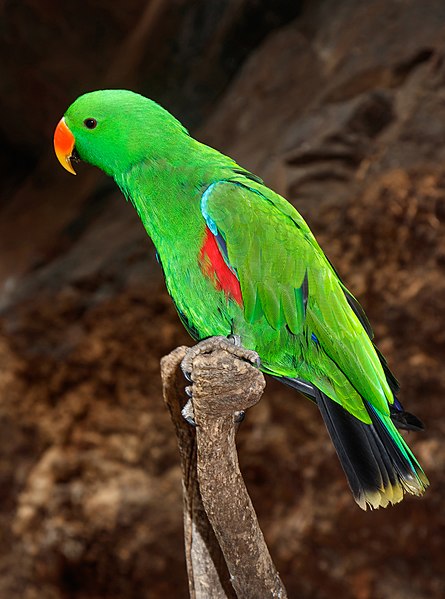No, not ‘eclectic’, Eclectus – the Eclectus Parrot, an extremely colorful, easily tamed, and social bird. These birds are fun! Native to Australia, New Guinea, and the islands of eastern Indonesia, they’re large parrots growing up to 15 inches in length.
There are actually nine subspecies of Eclectus parrots each very similar in appearance varying in the size of their heads, the brightness of their feathers, and the color of their heads. Regardless, they’re all absolutely gorgeous.

If you come across an Eclectus Parrot, you cannot help but want to touch them. Their feathers are almost like hair and are tightly interlocked to give them a silky coat that begs them to be petted. Their coloring is more brilliant than the most vibrant rainbow.
The males are a vibrant green with a horn-colored beak, a cluster of blue on their wings, and a bright red under their wings. Yep, rainbow! The females are red with brilliant blue underbelly and black beaks. They are among the few birds whose gender is so easily identified; most birds are difficult to sex.
Due to the variety of subspecies, hybrid breeding is common and is strongly frowned upon. The majority of bird lovers, breeders, and environmentalists believe that it is important to keep the gene pool of these amazing birds pure. Beauty is more than skin deep; at least it is in the Eclectus Parrot. They are fantastic birds. Both intelligent and loving, it is difficult to find a flaw.
Incredibly social, they’re playful and enjoy hanging upside down, playing with you and your family members, and relish toys and time with their family. Want more? They can talk and quite often develop an extensive vocabulary. Even better, they’re not particularly noisy birds. Here is some more information on teaching them how to talk on cue.
Eclectus parrots are found in Lesser Sundas, Solomon Islands, New Guinea, and NE Australia. In the early 1980′s, they were found to be among the most common parrots in the Moluccan Islands. They originated from the Cape York Peninsula of Australia, the islands of Indonesia, the Solomon Islands, and New Guinea.

There are several subspecies of Eclectus parrots and the female feather color patterns in those subspecies vary as does their habitat and size. However, only a few of the subspecies are available in aviculture including the Grand, Red-Sided, Vosmaeri, and Solomon Island subspecies. Eclectus Roratus are birds of lowland forests and clumps of tall trees.
Their conservation status is listed as Least Concern. The Eclectus parrot is unusual for a parrot in that they have extreme sexual dimorphism. Known for their hair-like plumage, the males are generally a bright green with yellow upper mandibles and black lower mandibles. The males also have blue or red tails and wing feathers.
The females have red heads and blue to purple breasts, depending on the subspecies, and they have black beaks. Like a typical parrot, they have a curved beak with a downward-curving upper mandible which fits over a smaller, upward-curving lower mandible. They also have typical parrot feet with the two outer toes of the foot pointing backward and two forward pointing inner toes.
Eclectus Roratus are intelligent and are generally classified among the top three parrots for their talking ability. They are also able to mimic household sounds and can be trained to speak. They have two distinct calls. During the flight, they repeat a loud screeching sound. However, while they’re feeding they have a subdued cry.
They are strong fliers. In the wild, they go on long flights and fly high above the forest canopy. They travel in pairs or small groups and search the upper canopy for fruits and leaf buds. At night, they gather in large groups of up to 80 birds to roost for the night.
How Much Does an Eclectus Cost?
The cost of an Eclectus parrot can vary depending on a number of factors, including the age and sex of the bird, as well as the location and reputation of the breeder. On average, an Eclectus parrot can cost anywhere from $1,000 to $2,500.
In most cases, it is cheaper to adopt an Eclectus if there is a possibility to do so for you nearby. Look at classified ads and local groups.
When deciding on such a long commitment, it’s important to also consider the long-term costs of owning a pet parrot, such as food, veterinary care, and cage or aviary expenses.
How Long Do Eclectus Parrots Live
Most parrots generally live longer in captivity than in the wild. It is not the case for the Eclectus, which lives considerably more in the wild, reportedly up to 50 years. In captivity, most Eclectus parrots live around 25 years but there’s been a reported parrot that lived for 40 years.

Eclectus Roratus in the Wild
The Eclectus nest in holes in trees or among rocks or termite mounds. They’re female dominant and the females are not known to develop a strong bond with their males or with their humans. The males are more affectionate. During the breeding season, two eggs are laid in the nest. The female broods for approximately 28 days while the male feeds her. The young are independent at 12 weeks.
In the wild, their diet consists mainly of whatever they can find. They are not picky eaters and you will often see them eating most kinds of fruits including, apples, papaya, and even pomegranate. They also like to eat nuts which are not very healthy for them in large quantities. A small part of their diet also consists of leafy type substances.
The average lifespan of an Eclectus is approximately 30 to 40 years. They have a large wingspan and require a cage that enables them to spread their wings and exercise. They also like to climb and many avian enthusiasts recommend a macaw-type cage.
As with any bird, bigger Eclectus cages are better. They’re active birds and should be allowed out of their cages every day to exercise. The males are more gentle and loving, however, both are sensitive and do not do well in chaotic or noisy homes. They have a tendency to feather pluck when they’re stressed.
Daily Eclectus Roratus requirements are a pellet-based diet with plenty of fresh fruits and veggies. They are sensitive to diets that are too rich and seeds and nuts can be kept to a minimum. Clean water, a clean cage, plenty of exercise, and a calm environment are all required to raise a happy and healthy Eclectus Parrot.
